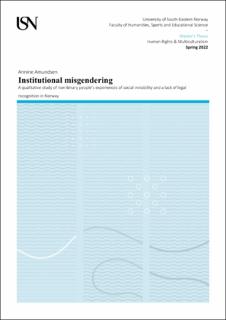| dc.description.abstract | Norway has an institutionalised binary system of gender that is reproduced through gender-specific regulations. One of these regulations is the fact that there are only two legal genders. This means that only people who identify as men or women are able to have a legal gender that correlates with their gender identity, and non-binary people are excluded from this right. The OHCHR argues that everyone should have their gender identity legally recognized, and that not offering this is a breach of state obligations on “freedom from discrimination, equal protection of the law, privacy, identity and freedom of expression”. This thesis will discuss Norwegian non-binary people’s experiences with this lack of recognition, and the social invisibility it can lead to. This will be done through discussing gender pluralism and degendering as strategies for recognition, as well as concepts of misrecognition, social invisibility, and institutional misgendering.
The findings of 14 qualitative interviews with non-binary people show that not having legal recognition can feel like being socially invisible. Additionally, lack of recognition was likened to misgendering, which led to the term “institutional misgendering” to explain non-binary people having to choose a legal gender that does not reflect their gender identity. Several of the informants saw a lack of legal recognition as a message from the government that they do not exist. This was the main reason they would like a nonbinary legal gender: as a proof of their existence. This is referred to as being institutionally visible, and legal recognition could be an important step towards reducing non-binary people’s feelings of social invisibility. However, some of the informants would prefer to remove gender markers instead, because they were worried about the consequences of a nonbinary gender marker. This can be called a dilemma between safety and recognition. Some of the informants are worried about the visibility a nonbinary legal gender could bring, while others are afraid degendering would render them socially and institutionally invisible. | |
